Inside Beam’s Queensland Headquarters

Brisbane, Queensland
Most Australian cities are at least somewhere along the progression of either trialling or fully implementing shared e-scooter and e-bike systems. But they’re all playing catch up to Brisbane, which is already five years down the path and has the largest share fleet.
Brisbane started with e-scooter share schemes in 2018 and Beam started operations there in July 2021.
This early start is in part because Brisbane City Council (BCC) is by far the largest local government in Australia, in terms of population, budget and the level of involvement it has in public transport operations.
BCC has currently licenced two share scheme operators, Beam and Neuron, which both have large fleets of e-bikes and e-scooters deployed throughout the city centre and surrounding suburbs.
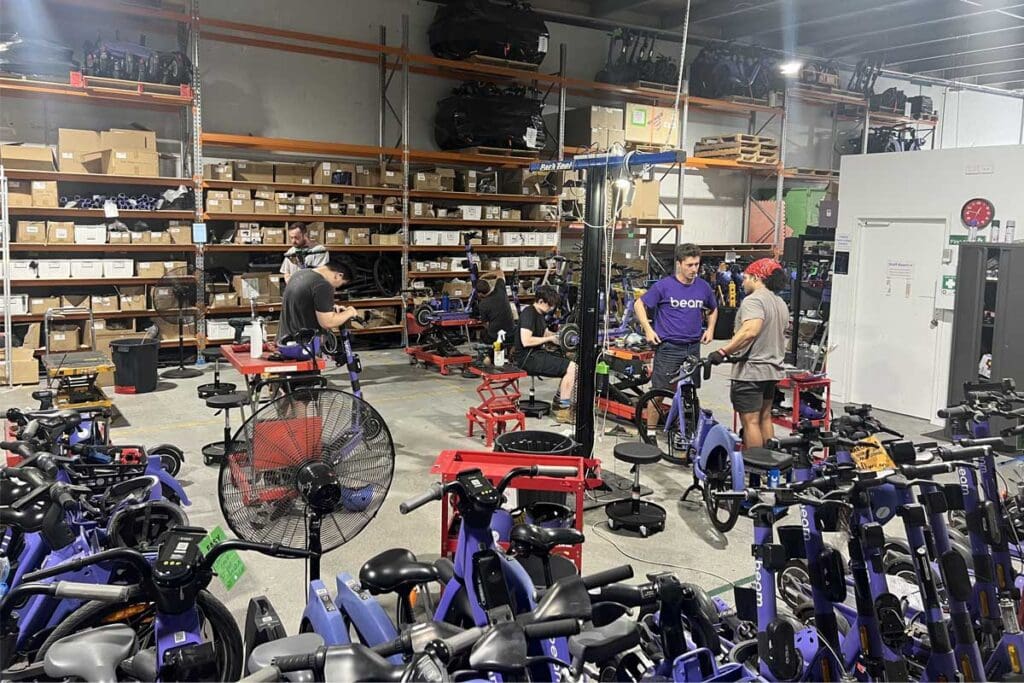
Anyone hiring a bike or scooter might not fully appreciate that every vehicle needs to be recharged and regularly maintained.
Therefore, both operators have large workshops close to the city centre, because the city and inner suburbs are the most active areas in terms of hires.
Beam’s HQ is in West End, just south-west of the CBD, on the opposite side of the Brisbane River. From here Beam services a fleet of 1,700 e-scooters and 400 e-bikes.
We were very fortunate to be given a tour of the facility with permission to take photos of both the operations and two interesting new protypes.
Our hosts were the Operations Manager for SE Qld, Andrew Dodd, Beam’s Head of Policy & Expansions ANZ, Sarah Taylor, and Product Enhancement & Hardware Manager ANZ Joao Soranz.
Sarah emphasised that everyone working at Beam is a direct employee of the company. There are no ‘gig economy contractors’. In total, there are now 240 employees across Australia and NZ.
Andrew said Beam’s ridership is up by 60% year on year.
Solar Powered Scooter
First, we looked at a new scooter with features including a camera, artificial intelligence (AI) and inbuilt solar power.
200 of these models will soon be going into service in Auckland, NZ, as the City of Auckland required the cameras in its contract terms.
The solar panel is incorporated into the scooter’s footboard. Although this is small in surface area, and the efficiency is presumably lower due to the thick, slightly opaque protective layer between the rider’s feet and the solar panel itself, depending upon sunshine and rate of usage, it still provides about 7% recharging per day.
Joao explained that future improved versions should increase this charging percentage.
He said batteries normally drain by 1% to 2% per day, even if a scooter is not ridden at all. This means scooters need to be recharged, even if they’re not ridden. The solar panel will cut down not just on electricity consumption at Beam’s recharging station, but on labour and transport, because batteries will not need to come back for charging as often.
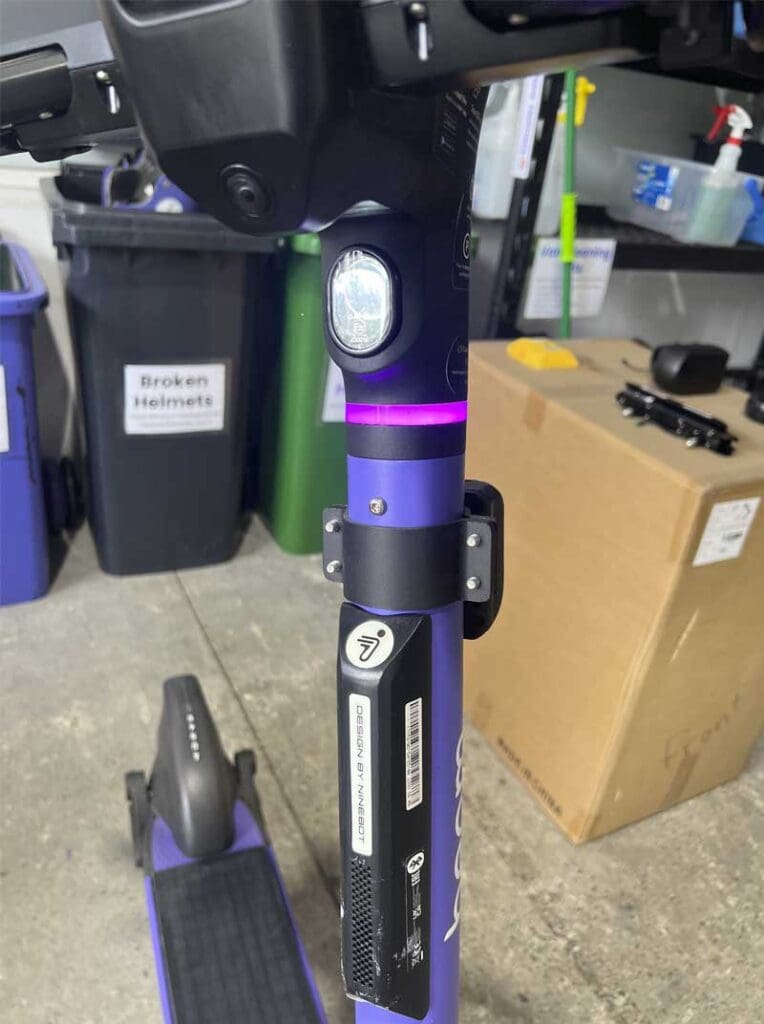
Beam is currently testing two scooters with solar footboards. It is planning to deploy 25 solar powered scooters in WA soon. No doubt more will follow once the technology is proven in Australian conditions.
Meanwhile, the AI adds a wide range of features, including lane detection, pedestrian detection and parking detection.
When an AI scooter first arrives in a city, it needs to be ridden and ‘trained’ to recognise the particular roads / footpaths / bike paths colours and locations in that city. That information is then shared with the entire fleet for that city.
The team at Beam is already riding its two AI prototypes all around town to do that initial training.
As we reported here, in late 2022 the Queensland Government introduced a range of new rules and penalties for people riding e-scooters. The issues they seek to address include tandem riding, ie two people riding together on one scooter. This is not legal in Queensland and heavy fines applying.
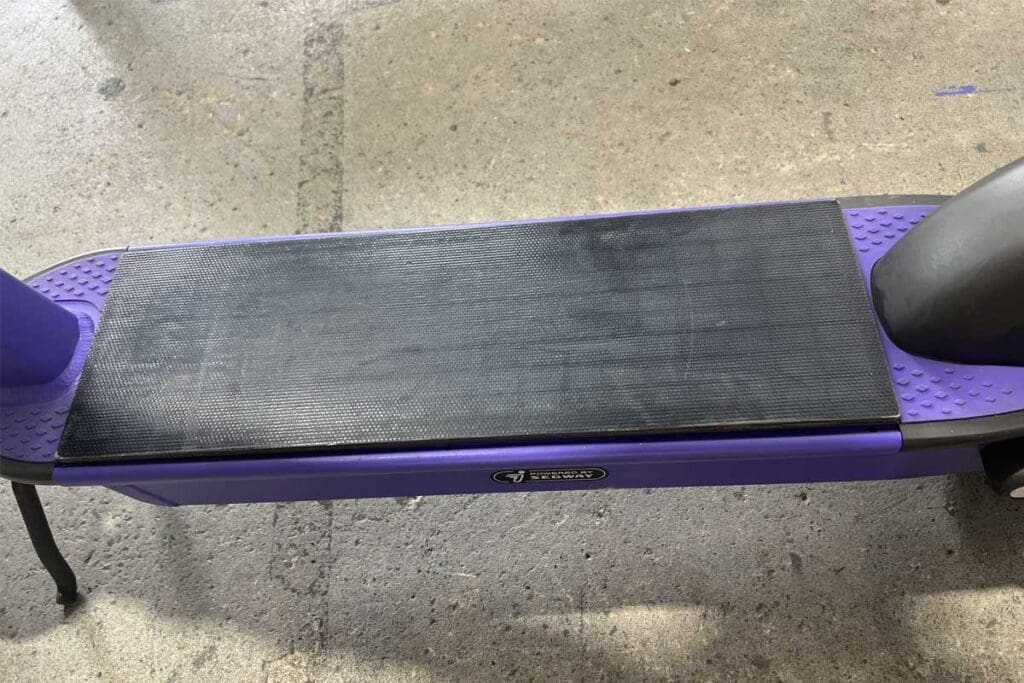
Creating safety rules is one thing, successfully and efficiently enforcing them is another. Beam’s new scooter includes a rear wheel sensor that is not simply measuring total weight, because one large rider could weigh as much as a smaller rider plus passenger. It also senses weight distribution and recognises ‘unweighting’ when the scooter stops at traffic lights etc. If there is a rider and a passenger, typically only the rider puts their foot down when they stop, so the percentage of weight decrease at stops is lower than for a single rider.
Therefore, the new AI system does not instantly know if there’s one or two riders. But when it has figured it out, it gives an audio warning and, if this is ignored, it will cut the scooter’s power.
The new scooter also combines information from GPS known data points with scooter movement sensed from the rear wheel. For example, the system will know that at a given moment the scooter has continued to roll a certain distance further on from the last GPS location point. This has sharpened the scooter locating accuracy from five to 10 metres previously down to just centimetres.
This is important for accurately identifying virtual parking docs, particularly in crowded city centres.
Beam will not have to replace its entire fleet to benefit from these new AI features. There is a retrofit AI version that can be bolted onto the current scooters.
Safety First
Like all share scheme operators, Beam knows the safety of both riders and other community members, especially pedestrians, is vitally important if share schemes are going be allowed to continue and grow throughout Australia.
Beam favours open data where every operator would share their incident information via a national register.
Meanwhile, Beam is testing what motivates good behaviour among its customers and, in particular, the relative effectiveness of ‘carrots versus sticks’.
The includes one well publicised issue when it comes to safety – abuse of share systems by late night revellers outside hotels and clubs.
Beam operates 24/7 in Brisbane, but certain areas are shut down between midnight and 5am, such as the nightclub precinct in Fortitude Valley.
It is also trialling a cognitive testing system on its scooters in Esperance, WA. Would-be riders get two chances to pass a test that can be easily done when sober, but not when under the influence. If they fail, the scooter won’t power up.
Parking Beacons
As anyone who’s ever used GPS to navigate in a major city centre knows, being surrounded by tall buildings is problematic because they can block direct satellite links and this can result in the GPS losing track of where it is.
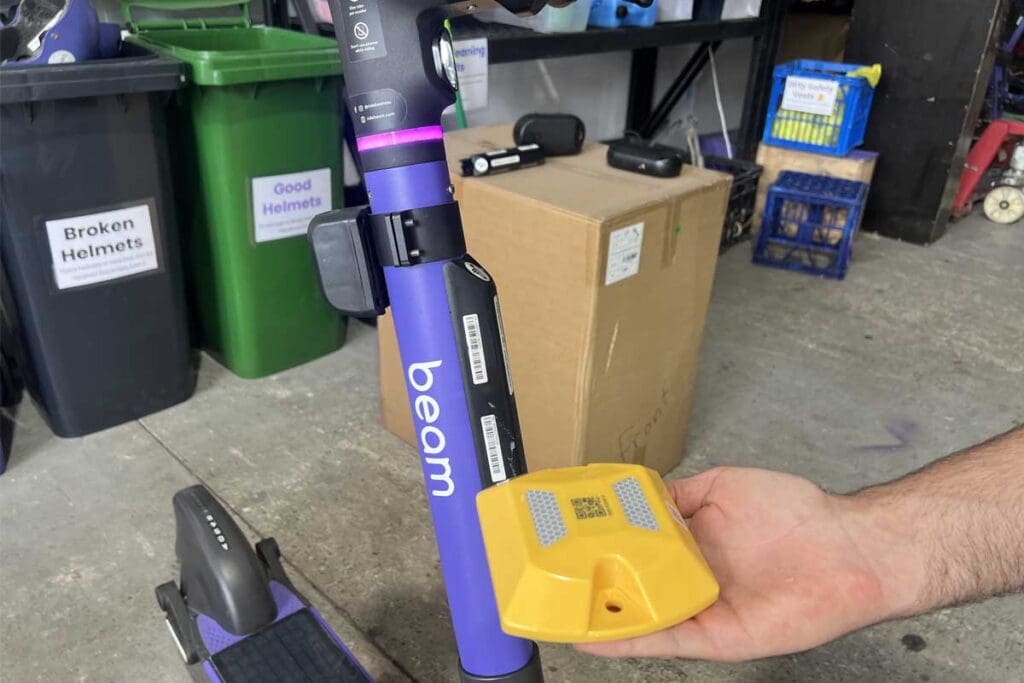
Beam is testing bright yellow beacons that look just like regular traffic reflectors. They are fixed in precisely known locations and send out a Bluetooth signal to the scooters so they can also determine their exact location.
Beam wants to avoid the need for physical parking racks in the crowded city centre, so these beacons should be another piece of technology that enables riders to precisely park within authorised areas. This beacon system is already used overseas but not yet in Brisbane.
Mopeds Coming Soon?
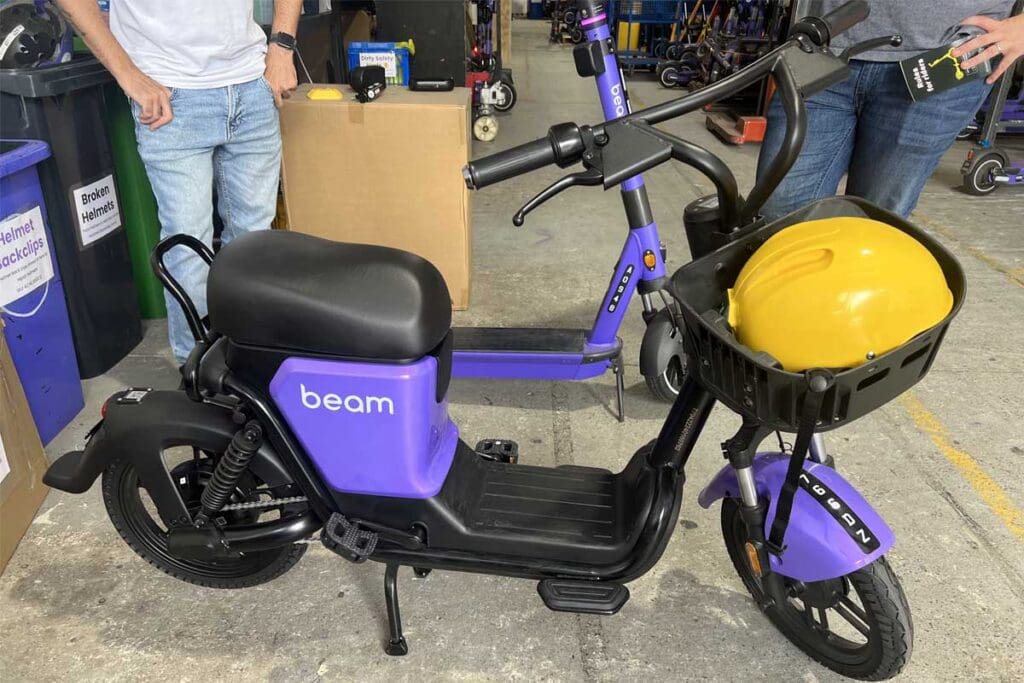
Customer feedback has shown there’s a demand for seated scooters, so Beam is also test riding a sample moped. The one photographed with this article is currently the only unit in Australia, but 400 of these mopeds are already in service in Indonesia.
The sample has a 760-watt motor and is speed restricted to 25kph.
The helmet sits in a moulded cradle within the front basket, with four sensors that confirm when it’s stored correctly.
Once on the rider’s head, these four sensors need to connect to the rider’s skull, through skin contact with the helmet liner. If not, the moped won’t power up.
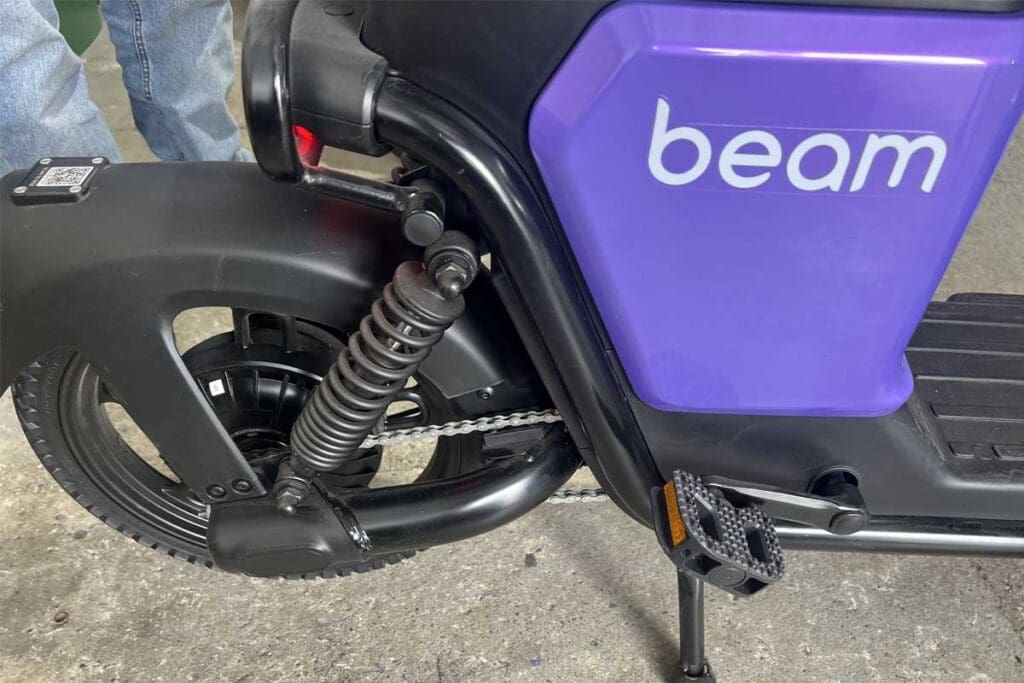
Safe Battery Charging
Battery charging is a hot topic at the moment, no pun intended, because of some well publicised fires in Australia and overseas. According to industry leaders, all the fires associated with micromobility devices have been caused by non-compliant batteries and charging equipment that does not have the correct software to avoid over charging.
Beam takes a range of additional safety measures and never leaves the charging area unsupervised. There are always staff present and it’s shut down when staff go home for the evening.
Beam has also fitted sensors to detect heat build-up and optimised the space between the batteries for better air flow.
At the end of the battery charging rack sits a brightly coloured wheelie bin half filled with water. If their sensors were to ever detect any heat build-up, the faulty battery would be put into the bin and the bin wheeled outside.
Beam is also planning to add thermal imaging as a further safety check.
Batteries take four hours to charge from completely flat and typically two to three hours for batteries brought back from the hire fleet. To retrieve the batteries, the Beam team uses a mixed fleet of modified cargo e-scooters and a small fleet of Tern GSD e-cargo bikes.
Conventional delivery vans are mainly used for rebalancing the fleet – ensuring bikes and scooters are relocated to where they’re most needed. Beam would like to invest in electric powered vans but needs longer-term contracts from cities to make this commercially viable.
It says some contracts for supplying share schemes in cities are as short as six months, while others are as long as five years. The latter is much more sustainable and allows Beam to invest in its fleet, team and overall set-up.
For example, Beam has a five-year permit in Esperance – the longest share scheme for any operator in Australia or NZ. This has allowed Beam to invest in electric vans.
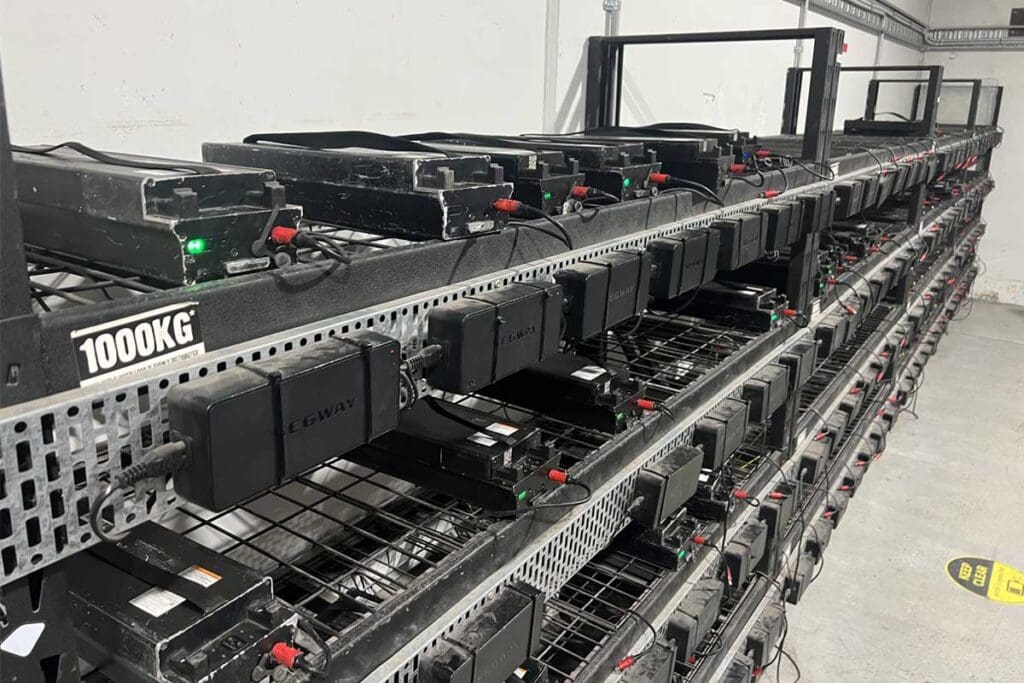
In shorter-term markets, Beam hires its vans, which are mostly ICE (internal combustion engine) powered.
The company also reports that share schemes in regional cities are doing very well – possibly because there is no alternative public transport.
The impetus for getting scooters into a city is often coming from the local government’s economic development team rather than its transport department. The economic development teams see the data showing share schemes drive tourism, more local shopping and other economic benefits.
Having visited Beam’s Brisbane HQ, we can only conclude that its technology, including safety and compliance systems which are already far more rigorous than anything required for private motor vehicle usage, are continuing to improve at a rapid rate.
There is more growth ahead for micromobility share schemes throughout Australia and NZ, provided regulators keep working in constructive collaboration with operators to make improvements wherever required. It would be a terrible shame if regulators and elected officials are pressured into making knee-jerk reactions because of tabloid media articles that prefer sensationalist scaremongering over objective reporting.

What about these thermal runaway events???
https://www.canberratimes.com.au/story/7275719/fire-crews-remain-at-fyshwick-scene-overnight-over-safety-concerns/
https://www.nzherald.co.nz/nz/loud-bang-smoke-beam-investigating-after-e-scooter-malfunction/RUUTALLC2FRZFPZ5OUPPYB32LU/
https://www.canberratimes.com.au/story/7344091/act-battery-warehouse-fires-spark-concerns/